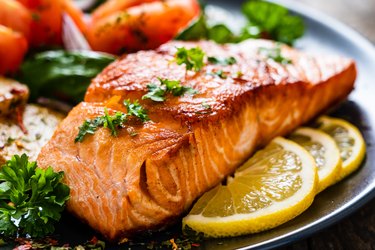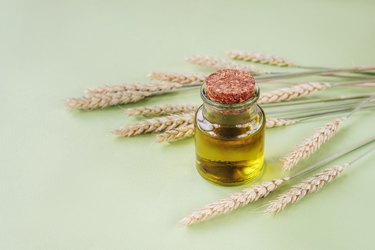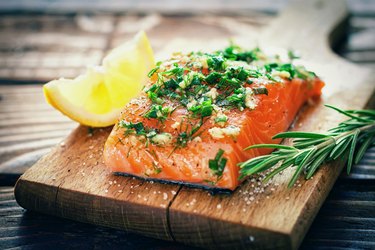Vitamin A is most known for maintaining healthy vision, but there's more to this nutrient than meets the eye.
There are two types of vitamin A, according to the National Institutes of Health (NIH):
Video of the Day
- Preformed vitamin A: found in animal products, such as meat, poultry, seafood and dairy
- Provitamin A: found in fruits and vegetables. The most common type of provitamin A is one you're likely familiar with is beta-carotene.
So what is vitamin A good for? Beta-carotene is a carotenoid (plant pigment) that gives foods, like carrots or tomatoes, an orange or red color. On its own, it's a powerful antioxidant, per the National Center for Biotechnology Information.
Video of the Day
The liver processes beta-carotene into vitamin A, which supports healthy vision and a strong immune system, plays a role in reproduction and helps your organs work properly, according to the NIH.
How Much Vitamin A Do You Need Per Day?
Your A intake is counted in micrograms of retinol activity equivalents, or RAE, a measure of the content and activity of vitamin A in foods.
Adults assigned female at birth need 700 micrograms of RAE of vitamin A per day while adults assigned male at birth need 900 micrograms of RAE per day.
Read on for the top vitamin A foods that, yes, are good for your eyes — and a whole lot more. Note that the FDA's Daily Value (DV) percentages are based on eating 900 micrograms of RAE of vitamin A per day.
Fruits and Vegetables High in Vitamin A
1. Sweet Potato: 214% DV
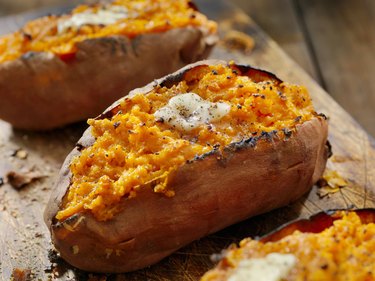
Sweet potatoes provide 1,922 mcg RAE or 215 percent of the DV for vitamin A per 1 cup cooked as well as complex carbs needed for energy and nearly a quarter of your daily needs for fiber. One medium baked sweet potato contains 122 percent of the DV for vitamin A.
Because vitamin A is fat-soluble (like vitamins D, E and K), it's important to make sure you're getting enough fat in your diet to help your body absorb the nutrient. Pair baked sweet potato with cheese or chili, two fat-rich foods that help your body absorb the vitamin A in the potato.
2. Carrots: 148% DV
What's up, Doc? Bugs Bunny must have 20/20 vision thanks to his love for crunchy carrots. The root vegetable is known for being eye-healthy, and that's thanks to its beta-carotene, which the body converts to vitamin A.
Per 1-cup cooked, you'll get 1,329 mcg RAE or 148 percent of the DV — so, yes, carrots are rich in vitamin A. If you prefer them raw like Bugs, a medium carrot clocks in at 44 percent of the DV.
3. Butternut Squash: 127% DV
Butternut squash, another orange vegetable, has 1,144 mcg RAE or 127 percent of the DV for vitamin A per cup cooked as well as fiber and vitamin C.
Pairing it with a fat source can help you absorb more A, so adding butter (or olive oil) to your butternut squash might not be such a bad idea. You can also try one of these protein-rich butternut squash dishes.
4. Spinach: 105% DV
We talked about Bugs Bunny and now we're on to Popeye the Sailor Man. Bugs loves carrots and Popeye loves spinach — both for good reason.
Cooked spinach provides 943.2 mcg RAE or 105 percent of the DV for vitamin A per cup cooked, as well as 740 percent of the DV for vitamin K (another fat-soluble vitamin) and good amounts of fiber, potassium and plant-based iron.
5. Mustard Greens: 96% DV
Related to kale, cabbage and collard greens (but less bitter), mustard greens can help you get vitamin A naturally: 1 cup cooked has 865.2 mcg RAE or 96 percent of the DV.
Like other leafy greens, mustard greens are also incredibly high in vitamin K. They sautee well with olive oil (which will help you absorb the vitamin A), salt and pepper.
6. Collard Greens: 80% DV
Speaking of collard greens, 1 cup of cooked collards contains 722 mcg RAE or 80 percent of the DV for vitamin A. Collard greens are also a good source of calcium and plant-based iron.
While collard greens are similar in nutrition to other leafy greens, like spinach and kale, they can be a welcome change in cooking: Just try one of these antioxidant-rich collard greens recipes.
7. Hubbard Squash: 76% DV
You might've seen a Hubbard squash at your local farmers' market or produce bin but instead picked up an acorn or butternut squash. Hubbard squash looks a little like a decorative gourd.
A 1-cup serving of cooked squash has 686.7 mcg RAE or 76 percent of the DV for vitamin A. Like other squash varieties, Hubbard also provides fiber, vitamin C and potassium.
8. Swiss Chard: 60% DV
If you're still looking for leafy greens that aren't spinach and kale, enter Swiss chard. This leafy green is popular among CSA (community-supported agriculture) bounties.
One cooked cup of Swiss chard contains 535.5 mcg RAE or 60 percent of the DV for vitamin A. Swiss chard also provides a good amount of magnesium, important for bone health, and vitamins C, E and K.
No matter the leafy green you prefer, eating one serving per day has been linked with slower age-related cognitive decline, according to a January 2018 study in Neurology.
9. Winter Squash: 59% DV
Like leafy greens, all sorts of squash varieties provide similar nutrition when it comes to vitamin A. Just 1 cup of cooked winter squash offers 535.1 mcg RAE or 59 percent of the DV.
Winter squash, in fact, isn't just one type of squash: The term encompasses several different varieties, including butternut squash, acorn squash, spaghetti squash and pumpkins. These squashes are harvested in the winter versus their summer squash sisters.
10. Cantaloupe Melon: 33% DV
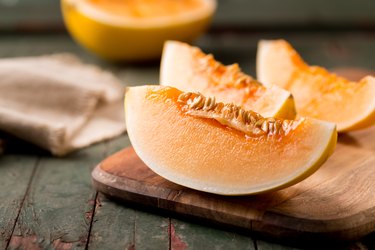
Cantaloupe melon is orange thanks to, yep, you guessed it: beta-carotene, the precursor to vitamin A. It's a fruit rich in vitamin A with 299.1 mcg RAE or 33 percent of the DV in a 1-cup serving.
Melon, like cantaloupe, is also a good source of vitamin C and potassium.
11. Red Bell Peppers: 26% DV
Fresh red bell peppers add a nutritious crunch to your snacks, salads and sandwiches. Per 1-cup serving, they provide 26 percent of the DV for vitamin A and 211 percent of the DV for vitamin C.
While red bell peppers contain higher levels of vitamins A and C than their green sisters, all bell peppers are good sources of fiber and water.
12. Romaine Lettuce: 23% DV
For those who prefer Romaine lettuce to spinach or kale, the salad favorite does provide some nutrition (plus plenty of water). A 1-cup serving contains 204.9 mcg RAE or 23 percent of the DV for vitamin A and 40 percent of the DV for vitamin K.
Lettuces like iceberg and Romaine are hydrating veggies, which makes them perfect for summer salads.
13. Apricots: 20% DV
Apricots are a fruit rich in vitamin A with 177.2 mcg RAE or 17 percent of the DV for vitamins A and C per cup as well as potassium, which is important for healthy muscle function.
Dried fruit makes for a tasty, nutritious mix-in to your favorite nut-based trail mix. Per 1 ounce, dried apricots provide 20 percent of the DV for vitamin A as well as fiber and quick-acting carbs for energy.
Tip
Dried fruits are higher in sugar than their fresh counterparts because their sugar is more concentrated, so make sure to stick to just one serving a day.
14. Pink Grapefruit: 15% DV
This tart citrus fruit is a refreshing summer favorite that delivers 133.4 mcg RAE or 15 percent of the DV for vitamin A and 80 percent of the DV for vitamin C per cup.
Grapefruit juice also provides a bit of vitamin A: 4 percent of the DV per cup, but fruit juice should be limited due to its high sugar content.
Tip
Pink grapefruit contains about 30 times more vitamin A than its white counterpart.
15. Broccoli: 13% DV
Broccoli, a cruciferous veggie, provides a variety of nutrients, including vitamin A — 120.1 mcg RAE or 13 percent of the DV per cup cooked — 112 percent of the DV for vitamin C and 183 percent of the DV for vitamin K.
Before you forgo the idea of eating broccoli because you can't stand it steamed, there are several delicious ways to cook it, including roasted with salt and pepper, sauteed in a stir-fry and grilled.
16. Zucchini: 11% DV
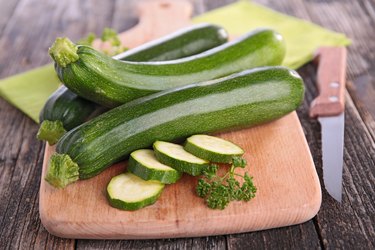
Summer squash, like zucchini, provides similar nutrition to its winter cousins. But zucchini contains less vitamin A — 100.8 mcg RAE or 11 percent of the DV per 1-cup, cooked — than winter squashes.
Zucchini is a good source of water and also provides vitamin C.
17. Mangoes: 10% DV
This sweet, juicy fruit is rich in flavor and nutrients, including vitamin A with 89.1 mcg RAE or 10 percent of the DV per 1-cup and vitamin C with 67 percent of the DV.
While mangoes do provide important nutrients, they're also high in sugar with nearly half of your DV.
Tip
If you're trying to manage your sugar intake, enjoy mangos in moderation and choose lower-sugar fruit like berries more often.
18. Asparagus: 10% DV
You may have heard that eating asparagus might cause stinky pee. While that might be true for some people, it doesn't take away from the nutrition it offers (plus, there's nothing wrong if your urine does smell after eating asparagus).
A 1-cup serving provides 90 mcg RAE or 10 percent of the DV for vitamin A, 102 percent of the DV for vitamin C and nearly 200 percent of the DV for vitamin K. Toss it on the grill or eat raw in your favorite salad.
19. Tomatoes: 7% DV
Bright red, juicy and bite-sized, cherry tomatoes are the perfect snack or salad topper. One cup has 62.6 mcg RAE or 7 percent of the DV, as well as nearly a quarter of your daily need for vitamin C.
Tomatoes also provide a powerful antioxidant, lycopene, which has been linked to a lower risk of stroke, per an October 2012 study in Neurology.
20. Brussels Sprouts: 7% DV
Brussels sprouts, a Thanksgiving favorite (for some, anyway), are a low-calorie veggie with a host of good-for-you nutrients.
Per cup cooked, Brussels sprouts have 60.8 mcg RAE or 7 percent of the DV for vitamin A, 107 percent of the DV for vitamin C and 182 percent of the DV for vitamin K.
Try these unique recipes for Brussels sprouts — none of which are roasted.
21. Guava: 6% DV
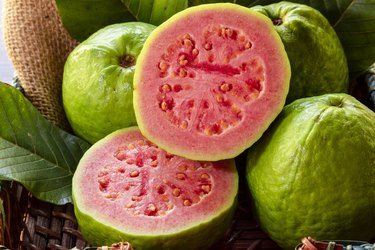
This tropical fruit boasts 419 percent (!) of the DV for vitamin C per 1-cup serving, and it also contains 51.2 mcg RAE or 6 percent of the DV for vitamin A and 32 percent of the DV for fiber.
Animal-Based Foods High in Vitamin A
22. Beef and Lamb Liver: 245% DV
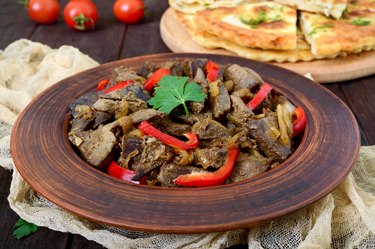
Because our livers process beta-carotene from plants into vitamin A, it makes sense that animal livers contain the vitamin.
Just 1 ounce of cooked lamb liver has 2206.2 mcg RAE or 245 percent DV and 1 ounce of beef liver has 2195.4. mcg RAE or 244 percent DV.
23. Eel: 107% DV
One 3-ounce filet of cooked eel gives you 966.5 mcg RAE or 107 percent of your DV. You can make eel at home by roasting it for about 30 minutes and seasoning with lemon and your favorite spices.
24. Clams: 32% DV
Though small, clams are nutritious: Per 6 ounces, cooked clams have 290.7 mcg RAE or 32 percent of the DV for vitamin A and an incredible 7,005 percent of the DV for vitamin B12.
Vitamin B12 is water-soluble, which means you don't store it and instead pee out the excess, so there aren't any ill effects associated with high intakes (especially from food), per the Mayo Clinic.
25. Cuttlefish: 19% DV
A 3-ounce filet of cooked cuttlefish gives you 172.5 mcg RAE or 19 percent of your DV for vitamin A. Despite the "fish" in its name, cuttlefish is related to the squid and octopus.
26. Skim Milk: 17% DV
One glass of skim milk supplies 129.5 mcg RAE or 17 percent of the DV for vitamin A while whole milk has just 12 percent of your DV. That's because whole milk doesn't get fortified with vitamin A like reduced-fat, low-fat and non-fat milk do.
Here's why: Dairy fat naturally contains vitamin A and when the fat is removed from dairy, some of the vitamin A goes along with it. Because of this, the Food and Drug Administration requires the lower-fat versions to be fortified with vitamin A, per the International Dairy Foods Association.
27. Goat Cheese: 15% DV
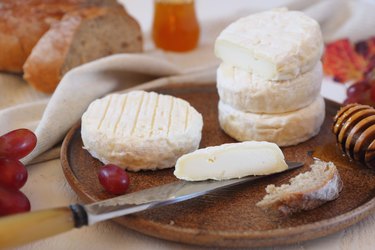
Hard types of goat cheese have 138 mcg RAE or 15 percent of your DV of vitamin A per ounce. But note that soft goat cheese has less: 1 ounce has 9 percent of your DV.
28. Salmon: 13% DV
A 6-ounce serving of farmed Atlantic salmon has 117.3 mcg RAE or 13 percent of the DV for vitamin A. Farmed salmon actually has more vitamin A than wild salmon, but the latter has less saturated fat.
29. Butter: 11% DV
One tablespoon of butter has 97.1 mcg RAE or 11 percent DV. If you're using butter substitutes, check the nutrition facts panel to see if your pick is fortified with vitamin A.
30. Cheddar: 11% DV
One ounce of cheddar has 95.7 mcg RAE or 11 percent DV for vitamin A. You'll also get nearly 7 grams of protein as well as bone-supporting calcium.

